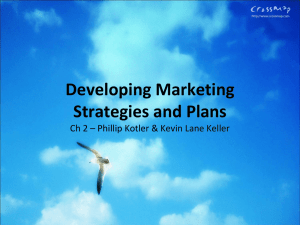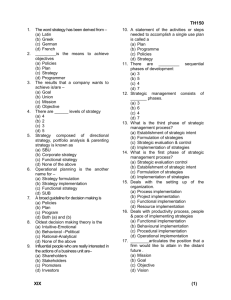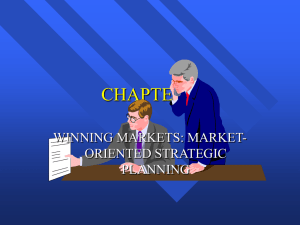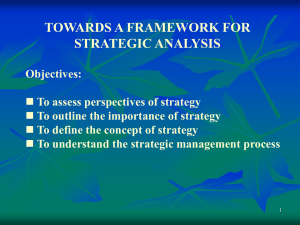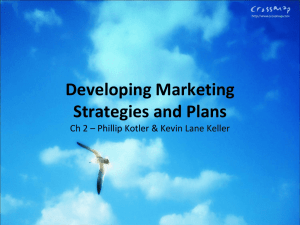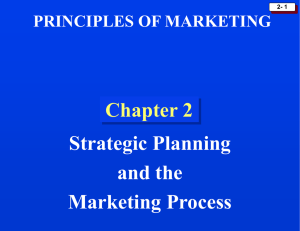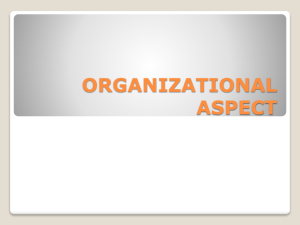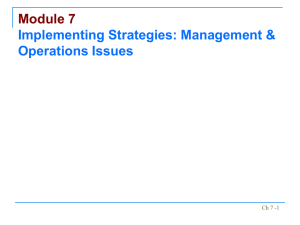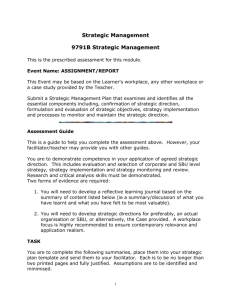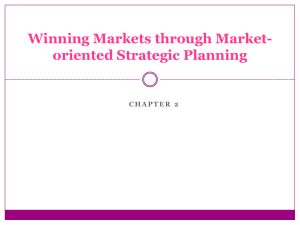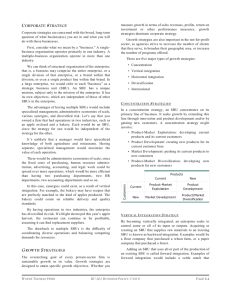Ch6 Strategy Implementation
advertisement
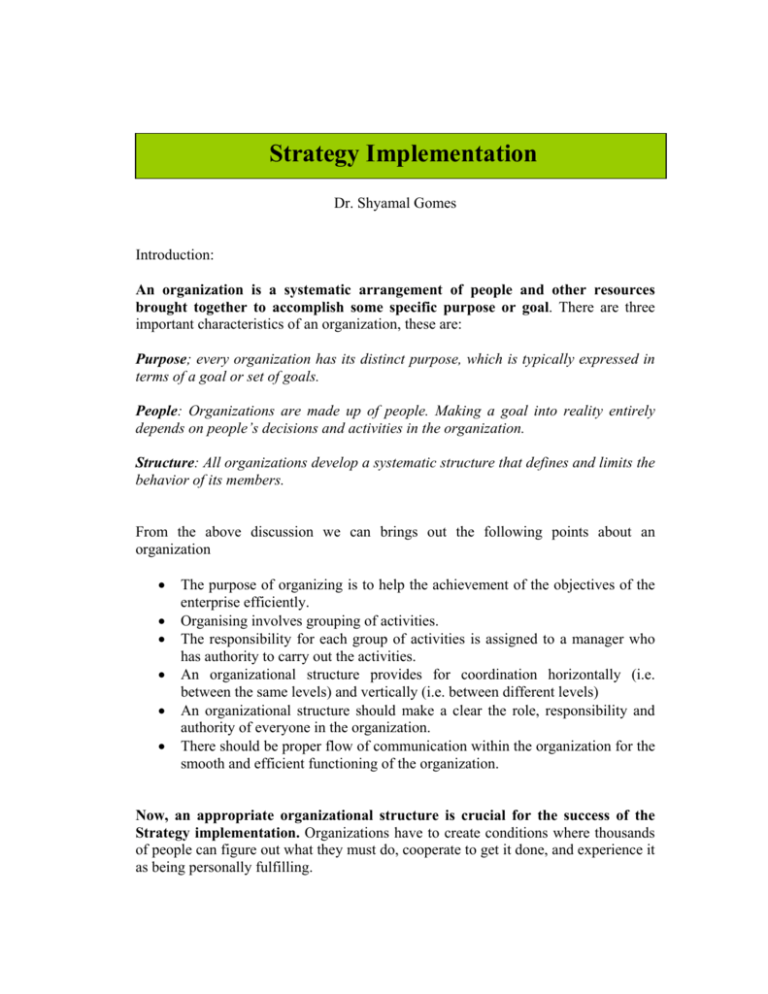
Strategy Implementation Dr. Shyamal Gomes Introduction: An organization is a systematic arrangement of people and other resources brought together to accomplish some specific purpose or goal. There are three important characteristics of an organization, these are: Purpose; every organization has its distinct purpose, which is typically expressed in terms of a goal or set of goals. People: Organizations are made up of people. Making a goal into reality entirely depends on people’s decisions and activities in the organization. Structure: All organizations develop a systematic structure that defines and limits the behavior of its members. From the above discussion we can brings out the following points about an organization • • • • • • The purpose of organizing is to help the achievement of the objectives of the enterprise efficiently. Organising involves grouping of activities. The responsibility for each group of activities is assigned to a manager who has authority to carry out the activities. An organizational structure provides for coordination horizontally (i.e. between the same levels) and vertically (i.e. between different levels) An organizational structure should make a clear the role, responsibility and authority of everyone in the organization. There should be proper flow of communication within the organization for the smooth and efficient functioning of the organization. Now, an appropriate organizational structure is crucial for the success of the Strategy implementation. Organizations have to create conditions where thousands of people can figure out what they must do, cooperate to get it done, and experience it as being personally fulfilling. • • Tom Peters and Waterman in their famous book “In Search of Excellence; lessons from American best run companies” point out that the success of an organization depends on a number of mutually supporting variables, beside Strategy and Structure. Their research has shown that any intelligent approach or strategy to organizing had to encompass, and treat as interdependent, at least seven variables – structure, staff/people, skills / management, style/ leadership , systems and procedures, guiding concepts and shared values ( culture). They defined this idea more precisely and elaborated what came to be known as the McKinsey 7-S Framework. These seven elements are distinguished in so called hard S’s and soft S’s. Though the successfully implementation of a strategy depends on the right alignment of all the seven elements. Peters and Waterman found that in the successful implementation of strategy perhaps the most effective tool within the control of management were the ‘structure’ ‘Strategy’ and ‘systems’ – the 3 hard S’s. The other elements of the 7 S framework, the soft S’s, were generally not within the control of management, at least in the short and medium run. They are determined by the people at work in the organization. Therefore it is much more difficult to plan or to influence the characteristics of the soft elements. Though successful strategy implementation requires a suitable organization structure to translate ideas into concrete action plans, in spite of having all these supporting elements, strategy implementation, is still found to be challenging. Creating a ‘fit’ of the organization’s strategic intent with its activities is complex. Strategy is dependent on many variables - internal as well as external. Now, a strategy is usually successful when all the elements in the 7-S framework fit into or support the strategy. SI is the sum total of the activities and choices required for the execution of a strategic plan. It is the process by which strategies and policies are put into action through the development of: Programs, Budgets, and Procedures. Strategy implementation, often descried as the action phase of the Strategic Management Process (SMP) , covers strategy activation and evaluation and control. What is Strategic Implementation? SI is concerned with the design and management of systems to achieve the best integration of – people, structure, process and resources in reaching organizational purpose. ( Steiner, Miner & Grey). SI involves actually executing the strategic game plan. It includes setting policies, designing the organizational structure, developing a corporate culture to enable the attainment of organizational objectives. ( Harvey). Therefore we can consider the following: SI is the sum total of the activities and choices required for the execution of a strategic plan. It is the process by which strategies and policies are put into action through the development of: Programs, Budgets, and Procedures SI, often described as the action phase of SMP, covers strategy activation and evaluation & control. SI is operational sing the strategies in business environment. Although implementation is usually considered after strategy has been formulated, implementation is a key part of strategic Management. Strategic formulation and strategic implementation should thus be considered as two sides of the same coin. Poor implementation has been blamed for a number of strategic failures. Without a proper fit between strategy and organizational design, various elements required for implementation will not move in harmony, ultimately leading to inefficient use of facilities and failure. Arvind Mills is one of the best examples of how a good strategy can result in a disaster through poor strategy Implementation. Strategy activation encompasses: • • • • • Communicating and motivating Setting goals Formulating policies and functional strategies Organizational structuring Leadership implementation and • Resource allocation To begin the implementation process, strategist must consider 3 important questions: 1. Who are the people who will carry out the strategic plan? 2. What must be done? 3. How are they going to do what is needed? Unless top management can answer those basic questions satisfactorily, even the bestplanned strategy is unlikely to provide the desired outcomes. However, strategy implementation phase may break into 3 components: 1. Operationalizing the strategy (communicating strategy, setting annual objectives, developing divisional strategies and policies and resource allocation like physical and financial resources) 2. Institutionalizing the strategy (organizational structuring and leadership implementation) 3. Evaluation and control process of the strategy Effective Steps in Smart Strategy Implementation: A. Formulation of SBU Strategy: In multi – SBU companies, the corporate strategy is implemented through SBU strategies, which are formulated to achieve corporate strategy. Corporate Strategy SBU Objectives Evaluation and Control SWOT of SBU Strategic alternative and choice Implementation Plan and Action B. Leadership Implementation: Leadership implementation refers to ensuring the right people in positions responsible for implementation of the strategy. It encompasses the chief executive officer (CEO) and the key managers. “ The first dimension of leadership implementation is to make sure that the right strategists are in the right positions for implementing the strategy chosen for the SBU or firm.” The ability, integrity and commitment of the CEO and other top executives are very critical role player to the successful implementation of the strategy C. Communicating the Strategy: In strategy implementation, involves a number of people at different levels. Many of them might not have taken part I strategy formulation. This highlights the importance of communicating the strategy to every member in right time. Even those who are not directly involved in Strategy Implementation need to be informed about the strategy because everybody in the organization should know: • What are the future plans for the organization • Why these changes are affecting the organization • Why these changes or strategy, • What are the objectives and implications? Absence of such information / communication would create a feelings of alienation in the employees causing morale and motivation to dampen and would also cause resistance to the strategy. D. Annual Objectives: While long term objectives are broadly started, annual objectives very specially lay down the annual goals for the business, functional areas or sub units. Annual Objectives should be: • Measurable • Consistent • Reasonable • Challenging • Clear • Communicable • Time bound and • Accompanied by commensurate rewards and sanctions. However, as annual objectives are formulated for a number of functional areas, unit’s etc. consistency, coordination and Integration are very critical factors here. E. Functional Strategies: Functional or short-term strategies help in implementation of grand strategy by organizing and activating specific sub units of the company (marketing, finance, production etc.) to pursue the business strategy in daily activities. In a sense, functional strategies translate thought (ground strategy) into action designed to accomplish specific annual objectives. For every major subunit of a company, functional strategies identify and coordinate actions that support the grand strategy and improve the likelihood of accomplishing annual objectives. F. Resource Allocation: Making sufficient resources (Financial, human, material, technological, facilities etc.) available in time is an essential requirement for effective implementation of the strategy. Top management’s commitment to the strategy will be reflected in the resource allocation. The resource allocation process is summarized as follows: ASSESS RESOURCE REQUIREMENTS Financial Human Technological Material Facilities Process / develop Resource Required Resource Allocations Process Operations Budget Capital Budgets Financial Budgets G. Development of Policies: Effective implementation of Strategy requires formulation of policies. ‘A policy is a broad, general guide to action which constraints or directs goal attainment ……….. Thus, Policies serve to channel and guide the impl. of Strategies. There are 3 types of policies in organizations: 1. Corporate Policies: apply through out the organization. 2. Divisional Policies: apply within a particular division 3. Departmental Policies: Within department Departmental Policy Divisional Policy Organizational / Corporate Policy H. Organizational Implementation: A strategy cannot be effectively implemented unless there is a suitable org. structure for the strategy in an organization. As Alfred Chandlu concluded – “ Structure follows Strategy” I. Evaluation and Control: To help implement the strategy effectively, it is essential to have an effective system of Evaluation and Control. The objective is to examining whether the strategy as implemented is meeting its objectives and if not to take immediate corrective measures. Evaluation is periodic and control or monitoring is regular. J. Reward: Effective Implementation of the strategy also depends on the motivation of executives and others associated with the implementation. It is therefore, necessary to have a system of Reward on performance. It may consist of monitoring like pay rises, bonus, and promotion etc. or non-monetary like awards, special acknowledgement etc. Reward is nothing but boosting the employees who are linked with effective strategy implementation. Different Approaches to SI Effective implementation of strategy needs, first of all , a clear and appropriate approach to the implementation. Based on their research on management practices in a number of companies, David R. Brodwin and L.J. Bourgeohis III, “Five steps to strategic Action” have identified five fundamental approaches to implementing strategies • • • • • Commander Approach – top down approach and those who implement the strategy are not involved in the development of strategy, they may not have the required emotional commitment to see the strategy successful. Organization Change Approach – here the strategy formulation resembles the commander approach but differs substantially in the approach to implementation of the strategy by giving focus on organizational structure and staffing. Collaborative Approach - ‘Collective Endeavour’ under this approach, brainstorming sessions are usually employed to formulate strategy and implementation tactics Cultural Approach- extends the democratic elements of the collaborative approach further to include lower levels in the organization. Crescive (increasing or growing) Approach – bottom up approach – instead of pushing the strategy downward from top management or a strategy group, it moves upward from the doers (sales people, engineers, production workers) and lower middle - level managers and supervisors. However, Brodwin and Bourgeois, the Crescive approach is suitable for large, complex, diversified organizations where the CEO cannot know and understand all the strategic and operating forces that affect each division. Finally we can say that a good strategy by itself does not ensure success. The success depends, to a very large extent, on how it is implemented. Many strategies fail to produce the expected results because of the failure in properly implementing the strategy.
